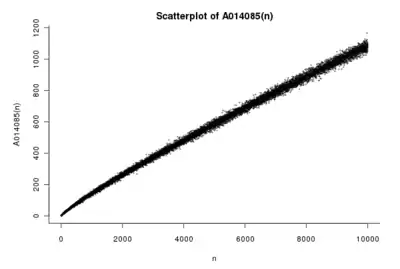Legendre's conjecture
Legendre's conjecture, proposed by Adrien-Marie Legendre, states that there is a prime number between and for every positive integer . The conjecture is one of Landau's problems (1912) on prime numbers; as of 2023, the conjecture has neither been proved nor disproved.
Does there always exist at least one prime between and ?
Prime gaps
If Legendre's conjecture is true, the gap between any prime p and the next largest prime would be , as expressed in big O notation.[lower-alpha 1] It is one of a family of results and conjectures related to prime gaps, that is, to the spacing between prime numbers. Others include Bertrand's postulate, on the existence of a prime between and , Oppermann's conjecture on the existence of primes between , , and , Andrica's conjecture and Brocard's conjecture on the existence of primes between squares of consecutive primes, and Cramér's conjecture that the gaps are always much smaller, of the order . If Cramér's conjecture is true, Legendre's conjecture would follow for all sufficiently large n. Harald Cramér also proved that the Riemann hypothesis implies a weaker bound of on the size of the largest prime gaps.[1]
By the prime number theorem, the expected number of primes between and is approximately , and it is additionally known that for almost all intervals of this form the actual number of primes (OEIS: A014085) is asymptotic to this expected number.[2] Since this number is large for large , this lends credence to Legendre's conjecture.[3] It is known that the prime number theorem gives an accurate count of the primes within short intervals, either unconditionally[4] or based on the Riemann hypothesis,[5] but the lengths of the intervals for which this has been proven are longer than the intervals between consecutive squares, too long to prove Legendre's conjecture.
Partial results
It follows from a result by Ingham that for all sufficiently large , there is a prime between the consecutive cubes and .[6]
Baker, Harman and Pintz proved that there is a prime in the interval for all large .[7]
A table of maximal prime gaps shows that the conjecture holds to at least , meaning .[8]
Notes
- This is a consequence of the fact that the difference between two consecutive squares is of the order of their square roots.
References
- Stewart, Ian (2013), Visions of Infinity: The Great Mathematical Problems, Basic Books, p. 164, ISBN 9780465022403.
- Bazzanella, Danilo (2000), "Primes between consecutive squares" (PDF), Archiv der Mathematik, 75 (1): 29–34, doi:10.1007/s000130050469, MR 1764888, S2CID 16332859
- Francis, Richard L. (February 2004), "Between consecutive squares", Missouri Journal of Mathematical Sciences, University of Central Missouri, Department of Mathematics and Computer Science, 16 (1): 51–57, doi:10.35834/2004/1601051; see p. 52, "It appears doubtful that this super-abundance of primes can be clustered in such a way so as to avoid appearing at least once between consecutive squares."
- Heath-Brown, D. R. (1988), "The number of primes in a short interval" (PDF), Journal für die Reine und Angewandte Mathematik, 1988 (389): 22–63, doi:10.1515/crll.1988.389.22, MR 0953665, S2CID 118979018
- Selberg, Atle (1943), "On the normal density of primes in small intervals, and the difference between consecutive primes", Archiv for Mathematik og Naturvidenskab, 47 (6): 87–105, MR 0012624
- OEIS: A060199
- Baker, R. C.; Harman, G.; Pintz, J. (2001), "The difference between consecutive primes, II" (PDF), Proceedings of the London Mathematical Society, 83 (3): 532–562, doi:10.1112/plms/83.3.532, S2CID 8964027
- Oliveira e Silva, Tomás; Herzog, Siegfried; Pardi, Silvio (2014), "Empirical verification of the even Goldbach conjecture and computation of prime gaps up to ", Mathematics of Computation, 83 (288): 2033–2060, doi:10.1090/S0025-5718-2013-02787-1, MR 3194140.
